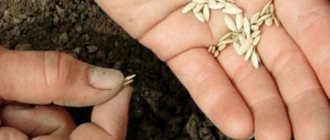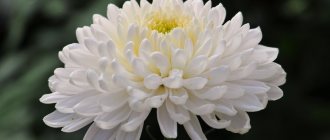Plants » Flowers
0
556
Article rating
Kira Stoletova
Some bulbous perennials tolerate wintering well, even in regions with prolonged frosts. And if the gladioli simply freeze, then the tulips and irises will only get stronger and acquire increased immunity, delighting with abundant flowering in the spring. According to many gardeners, planting irises in the fall will significantly save time for other spring work, and will create conditions for the early appearance of these delicate and luxurious flowers.
How to plant irises in the fall - step-by-step instructions
When is it better to plant irises: autumn or winter?
The name of the iris is associated with the rainbow: this is the name of the goddess of this natural phenomenon in Greek mythology
The main indicator on which all further development depends is that the iris must take root well. In spring and autumn this process occurs differently.
Advantages and disadvantages of autumn planting: table 1
| pros | Minuses |
| Irises have time to take root before real frost, so they bloom quickly in the spring | If the timing is incorrect, fragile plants may die from early frosts. |
| In autumn, pests threaten the plant much less than in spring. | |
| By planting flowers in the fall, the gardener frees up spring time for other important matters. |
Pros and cons of spring planting: table 2
| pros | Minuses |
| Immediately after planting, the flowers will begin to grow and take root. | The iris will not bloom until next season. |
| If the plant is poorly rooted, it will not tolerate possible sudden frosts. |
What are the features of autumn planting of irises, its pros and cons?
Planting of these flowers can be done in spring, summer or autumn. Gardeners believe that it is preferable to plant them in the fall (end of August - October).
Advantages of planting irises in autumn:
- the flowers will have time to settle in a new place before the onset of severe cold, will successfully overwinter, and will begin to grow in early spring;
- in the autumn there is less work on the garden plot, so such a transplant will free up valuable time in the spring, when the main work in the garden begins;
- In autumn, the number of harmful insects is greatly reduced; they cause less damage to flowers during this period than in the spring and summer periods.
The disadvantage of autumn planting of irises is the need to accurately determine the timing so that the seedlings do not freeze with the onset of cold weather.
Autumn planting of irises promotes their early spring development and flowering
There is no need to replant irises every year. They begin to grow after 3–5 years from the time of planting, then they will need division and replanting.
Dates for planting in open ground in the fall
There are more than 200 varieties of irises
Irises should be planted approximately 1.5 months before the onset of persistent frosts. The end of August is optimal for the northern regions, and October for the southern regions.
Depending on climate
In order for the iris to feel as comfortable as possible and take root well, planting should be done within the approximate time frame by region:
- Moscow and Moscow region: from September 1 to 15.
- Leningrad region: from August 5 to August 20.
- Krasnodar Territory and southern regions: from September 30 to October 15.
- Ural and Siberia: all of August.
Dates may vary depending on the prevailing weather and forecasts for the winter: if it is cold, it is better to plant irises earlier, if it is warm, the dates are moved forward a little.
According to the lunar calendar 2019
In order not to take unnecessary risks, when choosing a date, you should refer to the summer resident’s calendar. According to it, the following dates are suitable for planting:
- August - 31;
- September - 2–4, 11–12, 15–17;
- October - 1, 4–6, 12–14, 19–21.
If the iris rhizome is not planted immediately after digging, it must be wrapped in a dry, clean cloth and stored in a dark place. The room should be dry, cool and well ventilated.
Dates of autumn planting in the Moscow region and other regions
Irises take 5-6 weeks to take root. Calculate that from the moment of planting until the first frost there will be about this much time (no less than a month!). The specific period is determined by the climate in the region:
- southern Russia - all October;
- middle zone and North-West region - second half of September;
- Ural, Siberia, Far East - the first ten days of September (or even the end of August).
For planting, choose a warm (15–17°C), cloudy day. For those who follow the lunar calendar, new and full moon days are excluded. It is recommended to carry out any plantings during the waxing moon phase, especially when it is in the signs of Aries, Taurus, and Gemini.
Selection and preparation of a site
For the roots to spread freely, irises need space - at least half a meter from each other.
Irises need well-lit areas protected from gusty winds. It is optimal if it is a small hill so that rainwater does not stagnate near the roots. If groundwater is close to the surface, it will be necessary to provide an additional drainage system to prevent the roots from rotting.
Flowers thrive in nutritious loamy soils with weak acidity. Otherwise, the soil should be stabilized with crushed lime or dolomite flour.
About a week before the planned planting date, fertilizer should be added to the ground and dug several times. Per 1 m2 of soil there should be:
- 2 buckets of rotted compost;
- 150 g wood ash;
- 30 g superphosphate;
- 15 g potassium salt.
If the soil is too heavy and clayey, it is recommended to pour river sand into it when digging; if it is too loose and sandy, add a little clay for better moisture retention.
Growth stimulants and fertilizers containing nitrogen are contraindicated for autumn planting. Otherwise, the plant will begin to grow the above-ground part and will not be able to take root. In addition, you cannot use fresh manure for feeding: it can burn the tender roots of the plant.
The right place and soil for a flower bed
The unpretentiousness of irises allows them to take root in almost any conditions. But abundant flowering and maximum decorativeness can be achieved if you take into account the “wishes” of the plant:
- Good illumination (open area or light partial shade). A small hill or a place on a hillside closer to the top is suitable for irises. You cannot plant them under tall trees, bushes with a dense crown or next to them - not only the flowers and leaves need the sun, but also the roots. Flower buds do not form in the shade. In general, irises are not picky about their choice of neighbors and get along well with any flowers.
Irises are easy-going - you can plant any other flowers in the flowerbed next to them.
- No cold drafts. It is desirable to have a barrier at some distance that protects the irises, but does not obscure them.
- Groundwater located 1.5 m from the soil surface or below. The root system of irises is superficial; stagnation of moisture will provoke the development of rot. Bearded irises have a particularly negative attitude towards this, but Siberian and marsh irises are an exception; they can tolerate waterlogged soil.
Swamp irises, as the name suggests, feel comfortable almost in water, but this does not apply to other varieties
- Fertile soil, neutral or slightly acidic, well permeable to air and water. Bearded irises successfully take root even in rocky substrates.
Irises show the most abundant and long-lasting flowering when planted in an open area where they will have enough sun.
Instructions for planting irises
It is better to plant bearded iris in a fan along the slopes so that there is a good outflow of rain and melt water
Planting technology consists of several stages:
- Before starting the procedure, the planting material should be kept in a weak solution of potassium permanganate for about half an hour. This will help disinfect the roots and protect them from rotting.
- In the prepared bed, dig small holes 10–12 cm deep. The distance between them is determined depending on the variety and size of the adult plant. It can vary from 10 to 50 cm.
- Place a drainage layer of small pebbles, coarse sand or pieces of brick on the bottom. In the center you need to pour a small earthen mound 2–3 cm high.
- Place a seedling on the top of the mound and carefully straighten the root system inside the hole. It is important to ensure that the root collar and the curved part of the rhizome are exposed to the surface. The leaf fan should stand strictly vertically.
Siberian iris and marsh iris are best grown where it is always damp - near ponds and in partial shade
- Gradually compacting the roots, sprinkle them with soil so that it is distributed evenly. When everything is ready, the irises need to be watered (about 0.5 liters of water per plant). It is important to ensure that water does not get on the fan of leaves.
Features of planting irises in autumn, summer and spring
When choosing a time for planting or propagating irises, you should take into account the characteristics of its growing season at different times of the year.
In one season, irises go through several peaks of rapid growth:
1. In spring, rapid growth of the massive above-ground part occurs. In 40–50 days, irises grow a lush bush and flower stalks with buds. This requires a developed root system. Therefore, when planted in spring, flowering will be delayed until the following seasons.
2. In July, after flowering ends, the roots begin to grow new links. And later young buds are laid on them. To transplant in the summer, you need to track the moment when the root has grown, but the buds have not yet appeared. Young buds are very fragile and are often damaged during planting.
3. When planting irises in the fall (from late August to October), the root is already sufficiently developed, and the emerging buds are woody, strong and clearly visible, which is important when dividing the bush. Having taken root before the cold weather, such a plant overwinters well and begins to grow early in the spring.
In one season, a small seedling can grow into a bush capable of reproducing in the second year. The root of an adult iris, suitable for division and planting in the fall, is shown in the photo.
Preparing seedlings for wintering
After planting, water the plant only after three days.
After planting, irises require care. It consists of several procedures:
- Watering. If there is no heavy rain, the irises need to be watered 3-4 days after planting.
- Weeding. The beds must be regularly cleared of weeds. In the process, it is important not to touch the young roots that are close to the ground.
- Mulching. As cold weather approaches, it is important to monitor the temperature. Before the onset of the first frost, the roots must be mulched with spruce branches, dry leaves or peat. You can’t insulate it earlier, otherwise the roots will overheat and may rot. Remove the layer of leaves immediately after the snow melts.
Care after landing
Planting irises in the fall is not difficult, because they do not require constant attention from the gardener. Basic recommendations for care after autumn planting:
- Before the onset of frost, you need to carefully weed and loosen the soil by hand.
- Young iris should be watered in the fall immediately after planting and during periods of abnormal heat.
- Dry leaves, straw, and spruce branches are used for mulching. A layer of peat or humus will protect the roots from being washed out after rains.
- In regions with severe frosts, the plant is additionally covered with film, roofing felt or a structure made of boards.
Caring for seedlings and preparing for winter
The best option is to plant irises in separate flower beds (iridariums), on high beds (about 20 cm high). Even if the soil is sandy, such a measure will help prevent stagnation of water, especially in rainy weather.
When planting in autumn, the soil must be mulched (use peat, sawdust, or even just soil). Thanks to this, flower buds on seedlings are preserved. In the spring, as soon as the snow melts, the covering layer is removed.
To ensure that transplanted irises overwinter well, you should not rush to warm the plants early. But being late also has consequences. The best option is to skip the first frosts and cover the irises only with the onset of real frosts. Different covering materials are used (straw, foliage, peat, sawdust).
When using dry fallen leaves, it is necessary to prevent damping off of the plants. To do this, thin branches are first laid out on the site.
Any summer resident will agree that there are never too many irises. Since the flowering period of irises is approximately two weeks, to decorate the garden it is advisable to plant several different varieties with different flowering periods. And then you will be able to admire the exquisite elegant irises for a long time. Today we looked at the features of planting and transplanting irises to another place in the fall. We hope you find the information useful.
Preparing the site and soil for planting bulbous irises
A couple of weeks (and ideally 1 month) before planting bulbous irises, you should start preparing the site on the site of a private house or cottage. The procedure is extremely simple, just dig up the area with a shovel and put fertilizer under the digging.
If the land has not been filled with organic fertilizers for a long time, then it is advisable to add humus or compost (4-5 kilograms per square meter of area, but if the soil is very poor and infertile, then 8-9 kg). Phosphorus and potassium fertilizers should be added as mineral fertilizers, for example, superphosphate (40 g per sq.m.) and potassium sulfate (20 g per sq.m.).
In addition, if the soil in your garden is dense, heavy, or clayey, then it is imperative to improve the quality of the soil. To do this, river sand and non-acidic peat are also added to the digging (a bucket of each substance per square meter).
If the soil is acidic, be sure to deoxidize it. For example, you can use a deoxidizer; you can buy it at a garden store. Or you can add dolomite flour (200-300 g per sq.m. for slightly acidic soil, 400-500 g for very acidic soil).
If the soil in the garden is very light and sandy, then in addition to organic fertilizers, it is advisable to add peat and turf soil (or leaf humus), 1 bucket of each substance per square meter.
Then you should loosen the soil with a rake and level it if necessary. It is also advisable to spill the soil with warm water from a watering can with a diffuser (thanks to the water, the soil will settle to the desired level).
Advice! If your garden does not have suitable areas where you can plant flowers (waterlogged or unheated soil in the lowlands), then it is recommended to make high beds (20-50 cm high, depending on the severity). And before pouring the soil, you should put good drainage 10-15 cm thick, for example, broken brick, expanded clay, crushed stone.
Landing technology
Bearded and beardless varieties are very similar in planting technology and subsequent care - they are bred using roots or seeds.
In the second year, the root system already allows a single division.
For 4-5 years, she simply requires it, otherwise the plantings become thicker and the quality of flowering deteriorates greatly.
Propagation by roots
A well-grown healthy bush is selected for division. A month before transplanting, they stop fertilizing it, and watering is reduced by half.
To obtain planting material, you need:
- dig around the bush around the perimeter;
- carefully pull it out without tearing off the small roots;
- dry;
- using a sharp knife, divide into segments, each of which will contain a root section of at least 10 cm, a fan of leaves, several dormant buds;
- cut leaves to 13 lengths;
- Treat the cut areas at the root with crushed coal;
- as an option, disinfection is carried out with ash or a manganese solution;
- if a part of the rhizome without leaves is intended for planting, it is first kept in the sun (2-3 days) to improve growth;
- a mound is formed in the middle of the hole, lifting the rhizome above the ground;
- the bush sits on a hill, the feeding roots spread along its slopes;
- neighboring plants are planted no closer than 15 cm, large varieties require a distance of 45-50 cm;
- bulbous species are buried no more than 12 cm.
It is worth considering: if you need to quickly breed a variety, you can use small fragments of rhizomes without leaves.
For good growth and abundant flowering, new bushes are planted with the rhizome facing south. This factor must be taken into account when planning the size of the flower garden.
The plant is planted correctly if the fan of leaves is strictly vertical, the root part and neck protrude slightly from the ground. After 2-3 weeks the plant should take root confidently.
Growing from seeds
Rare varieties are grown from seeds
Sometimes you want to plant some special variety that your neighbors and friends don’t have. Such plants are ordered online or purchased in specialized stores. There they are sold mainly as seeds. The process will take longer; flowering will have to wait 2-3 years.
Marsh, Siberian, varietal, and Japanese species are grown from seeds. The disadvantage is the possibility of cross-pollination and disruption of parental characteristics.
Externally, the seeds are large and brown. They ripen for 2-2.5 months in seed pods after flowering.
Autumn sowing is preferable, because when storing seeds, their germination rate quickly decreases.
The timing is not important, the main requirement is at least 3-4 weeks before the first frost.
- The beds are prepared in advance at a distance of 20-35 cm.
- The seeds are buried 2 cm, covered with fallen leaves, mulch and a double layer of geotextile.
- The seedlings are transplanted to a permanent location in the spring, after the soil has warmed to +15 degrees.
Standard care in summer consists of weekly watering, fertilizing 3 times per season and regular weeding.
Information: it is unacceptable to use manure in any form.
Recommendations and common mistakes
Despite proper planting and careful care, there are times when the plant dies or does not bloom. One of the most common reasons is the wrong timing for the procedure. If you plant irises too early, they will begin to grow and die because they directed their energies not to rooting, but to increasing green mass. When planted in late autumn, the iris does not have time to adapt and prepare for frost.
Read more Planting irises in open ground in summer
You need to remove the tubers from the ground two weeks after the end of flowering. Most often, this period for most varieties occurs at the end of May, beginning of June.
Important! You cannot feed irises with manure; plants have a negative attitude towards this type of fertilizer.
If the summer is dry, then the tubers can be left in the soil until autumn.
Bulbs removed from the flowerbed need to be processed: soaked in a manganese solution and dried for 2-3 weeks. Before autumn planting, the material should be stored in a dry and ventilated area.
The main reasons why the crop does not bloom after autumn planting:
- insufficient lighting of the flower bed;
- the bulb was damaged;
- a flower bud froze;
- the soil is acidified and depleted;
- stagnation of moisture.
To establish the cause, you need to inspect the bush and make sure there is drainage. To do this, it is recommended to replant the crop in compliance with all agrotechnical rules.
It should be taken into account that iris varieties have different flowering periods. If the autumn planting is done correctly, the buds will appear next spring. If the bush has developed successfully over the summer, in the second year it will be possible to divide the root to propagate the variety.
There are irises that do not bloom after autumn planting. This may be due to varietal characteristics. It is recommended to continue to care for the plant, which will delight you with abundant flowering for 3-4 years of life.
Important! It is recommended to replant the flower every five years to preserve varietal characteristics.











